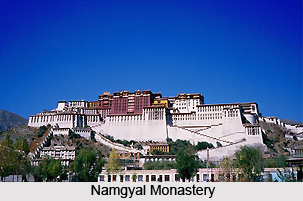 Namgyal monastery also known as `Namgyal Dratsang` is a Tibetan Buddhist monastery closely associated with all the Dalai Lamas since the third. This monastery is the personal monastery of His Holiness, the 14th Dalai Lama. A unique aspect of Namgyal monastery is its diversity of practice. It carries out prayers and rituals of all the major schools of Tibetan Buddhism. It is also an important centre of learning for Buddhist monks.
Namgyal monastery also known as `Namgyal Dratsang` is a Tibetan Buddhist monastery closely associated with all the Dalai Lamas since the third. This monastery is the personal monastery of His Holiness, the 14th Dalai Lama. A unique aspect of Namgyal monastery is its diversity of practice. It carries out prayers and rituals of all the major schools of Tibetan Buddhism. It is also an important centre of learning for Buddhist monks.
History of Namgyal Monastery
As found in the history, Namgyal monastery was first established in the 16th century by the 3rd Dalai Lama, Sonam Gyatso. He founded it in the year 1575. The monastery was established with an intention to carry on the public religious activities of Dalai Lama and also to perform prayers for the betterment of Tibet. At that time, it was located at the Potala Palace in Tibet. Its purpose was to assist the Dalai Lama in his spiritual duties and public religious activities. It was from here that he used to perform religious and ritual prayer ceremonies for the Tibetan Government and for the welfare of Tibet. However, it was later shifted and presently, it is located in the Dharamsala town in Himachal Pradesh.
Teachings at Namgyal Monastery
In the monastery premises, there is another monastery, an institute and few temples. The monastery remains close for the public and only His Holiness, Dalai Lama and his students are allowed to enter the monastery. Students are admitted in the institute to learn Tantra and Sutra for long thirteen years. The main tantric practices reportedly comprises of Kalachakra, Yamantaka, Chakrasamvara, Guhyasamaja, and Vajrakilaya. Any monk gains an admission in this monastery only after clearing series of challenging entrance examinations. Thereafter, they need to undergo the traditional training. The monastery is presently the home of more than one hundred and eighty monks.
Connectivity of Namgyal Monastery
The monastery can be accessed by air, rail as well as road. The nearest airport is Gaggal which is approximately 21 km away from Mc Leodganj (nearest town of Namgyal monastery) and is well connected to Delhi. The nearest railway station from Mc Leodganj lies at Chakki Bank from where trains connect to Delhi and Kolkata. Mc Leodganj is also well connected to Delhi by NH1 and NH21.



















